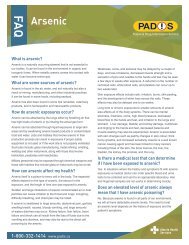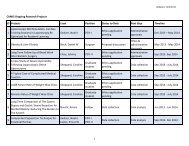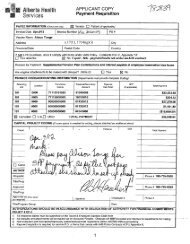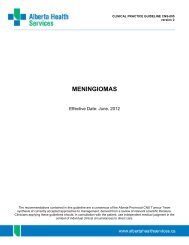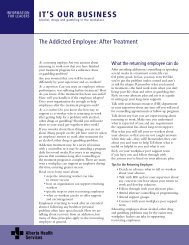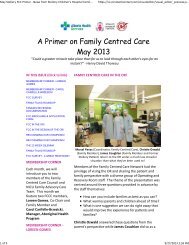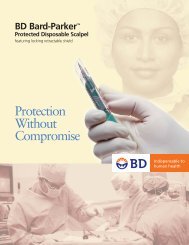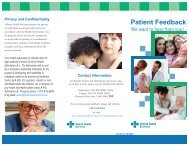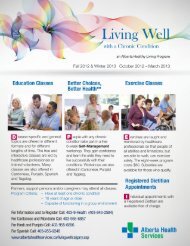Leaps and Bounds - Grade 4 - Lesson 8: Rounding Up Role Models
Leaps and Bounds - Grade 4 - Lesson 8: Rounding Up Role Models
Leaps and Bounds - Grade 4 - Lesson 8: Rounding Up Role Models
You also want an ePaper? Increase the reach of your titles
YUMPU automatically turns print PDFs into web optimized ePapers that Google loves.
<strong>Leaps</strong> <strong>and</strong><br />
bounds<br />
LESSON PLANS FOR GRADE 4<br />
<strong>Lesson</strong> 8<br />
<strong>Rounding</strong> up<br />
role models<br />
SPECIFIC OUTCOMES<br />
1. Recognize that individuals can have a positive<br />
<strong>and</strong> negative influence on the feelings<br />
of others.<br />
2. Assess how to act as important role models<br />
for others by<br />
· identifying personal feelings experienced<br />
as a result of positive qualities in others<br />
· underst<strong>and</strong>ing that role models set<br />
an example for others by making healthy<br />
lifestyle choices<br />
Demonstrate effective decision-making, focusing<br />
on careful information gathering by<br />
· considering the value of life<br />
experiences <strong>and</strong> relationships<br />
CONTENT AND TIME (45-MINUTE LESSON)<br />
8.1 Opening activity: Pondering peer<br />
pressure (5 minutes)<br />
8.2 Radiant role models (20 minutes)<br />
8.3 Producing a pledge (15 minutes)<br />
8.4 Review: What we have learned (5 minutes)<br />
REQUIRED MATERIALS<br />
BLACKLINE MASTER 8.2: Radiant role models<br />
Health books<br />
Chart paper<br />
Wax crayons/pencil crayons<br />
75
<strong>Leaps</strong> <strong>and</strong><br />
bounds<br />
LESSON PLANS FOR GRADE 4<br />
77<br />
<strong>Lesson</strong> 8<br />
8.1 Opening activity: Pondering peer pressure<br />
Ask the students to provide examples of situations where one friend talks<br />
another friend into doing something positive (picking up garbage on<br />
the playground, playing with a new student, joining the soccer team).<br />
Then ask them to provide examples of situations where one friend talks<br />
another friend into doing something negative (bullying another student,<br />
cheating on a test, stealing from somebody).<br />
Ensure the students underst<strong>and</strong> that peers are friends or classmates who<br />
are about the same age, <strong>and</strong> that peer pressure is when friends or classmates<br />
try to influence the decisions of others. Explain that peers can influence<br />
others into making wise decisions (positive peer pressure) or poor decisions<br />
(negative peer pressure), as seen in the examples above. Discuss with<br />
the class the desire most people have to be liked <strong>and</strong> accepted by their peers;<br />
however, at some point they may be faced with the responsibility of refusing<br />
to engage in an activity that they know to be wrong (bullying, stealing, taking<br />
drugs, etc.).<br />
8.2 Radiant role models<br />
Explain to the class that a person who provides a positive influence<br />
for others is defined as a role model. A role model is an individual<br />
■ whose actions set a positive example for others<br />
■ who has set admirable goals <strong>and</strong> has worked hard to achieve them<br />
■ who is admired for his or her positive qualities <strong>and</strong> contributions<br />
Encourage the students to think of an individual who is or could be<br />
a role model in their lives. Explain that this person can be a celebrity,<br />
a fictitious character or somebody the students know personally (such as<br />
a family member, an older friend, a coach or a teacher). While examples<br />
are being given, emphasize the exceptional qualities these individuals<br />
possess. For instance:<br />
“You look up to your mother because she came here from another country,<br />
on her own, without knowing the language. She is very brave. She had to<br />
overcome challenging obstacles to achieve her goals in life.”
<strong>Lesson</strong> 8<br />
Record as many qualities as possible on chart paper. The following is<br />
a list of examples.<br />
courage caution patience<br />
trustworthiness kindness sensitivity<br />
positive outlook compassion generosity<br />
loyalty energy gratefulness<br />
thoughtfulness humour dependability<br />
fairness responsibility honesty<br />
Following several responses, discuss with the class how positive qualities<br />
in others affect them personally. Ask them to think about how they feel<br />
when they are with someone who is trustworthy, or how they react to<br />
a person’s positive outlook. Encourage answers such as the following:<br />
“Someone who demonstrates patience influences me to be less irritable<br />
when things don’t go my way.”<br />
Ask why positive role models are important in discussions about drugs,<br />
alcohol <strong>and</strong> gambling. After giving the class the opportunity to make<br />
this conclusion, clarify that young people who have a positive example<br />
to follow often do not struggle as much with addictions. For these young<br />
people, a role model influences them to make wise decisions <strong>and</strong> guides<br />
them through difficult situations. This role model is an individual in whom<br />
they can confide <strong>and</strong> trust, somebody on whom they can lean for support<br />
in difficult times.<br />
Distribute BLACKLINE MASTER 8.2. The students will choose a personal role model<br />
to write about <strong>and</strong> record his or her name in the centre of the sun. Next,<br />
they will describe the qualities they appreciate about this role model inside<br />
the rays of the sun. In the tree leaves below, the students will describe how<br />
this role model makes them feel. <strong>Up</strong>on completion, they may colour their<br />
pictures.<br />
Challenge the students to discuss the symbolism in this picture. Have them<br />
compare the important effects of sunlight on leaves to a role model’s positive<br />
influence on others.<br />
As an extension to this activity, you may want to invite an appropriate role<br />
model during another health lesson as a guest speaker on a topic such as:<br />
78<br />
<strong>Leaps</strong> <strong>and</strong><br />
bounds<br />
LESSON PLANS FOR GRADE 4
<strong>Leaps</strong> <strong>and</strong><br />
bounds<br />
LESSON PLANS FOR GRADE 4<br />
■ the pursuit of goals in athletics, the arts, the community or in some<br />
other significant way<br />
■ the value of identifying what is important in life, making wise<br />
decisions to achieve the things worth having<br />
■ the difference a positive role model can make in a young person’s life<br />
This role model can be a university student, a musician, an athlete, an artist,<br />
a dancer, a counsellor, a school graduate or anybody with whom the students<br />
can identify.<br />
8.3 Producing a pledge<br />
Explain to the class that a personal promise is a pledge. It is an agreement<br />
with yourself to accomplish something in which you believe strongly.<br />
Pledges are often said aloud <strong>and</strong> sometimes with other people. Encourage<br />
the students to describe pledges they have made themselves or pledges they<br />
have heard others make (for example the Girl Guide or Boy Scout pledge).<br />
Ask the class to consider how making a pledge can guide an individual’s<br />
choices <strong>and</strong> behaviour.<br />
Help the students write a class pledge about healthy decision-making, using<br />
the knowledge they have gained in this unit. The following is a sample<br />
pledge:<br />
I promise to think about what is important in my life <strong>and</strong> how drugs <strong>and</strong><br />
gambling might hinder that. I will practice safety with medicines, I will make<br />
wise choices <strong>and</strong> I will surround myself with positive role models. I promise<br />
to make the most of me.<br />
Have everyone say the class pledge together.<br />
During another health lesson, you can extend this activity by asking<br />
the students to type the class pledge on the computer. You may also<br />
give them the option of writing <strong>and</strong> illustrating their own pledges. Ask<br />
the students to include two lines on the pledge form; one for their own<br />
signature <strong>and</strong> another for the signature of a witness who listens to them<br />
read their pledge. Have the students keep their completed pledge forms<br />
in their health books.<br />
79<br />
<strong>Lesson</strong> 8
<strong>Lesson</strong> 8<br />
8.4 Review: What we have learned<br />
As a class, ask the students to look through their health books <strong>and</strong> briefly<br />
review the activities completed. Encourage them to discuss the lesson<br />
themes, their favourite activities, personal thoughts about the most important<br />
concept learned or individual changes they would like to make as a result<br />
of this health unit.<br />
Assign students to add new information to the class bulletin board.<br />
Refer to the questions generated during the first lesson <strong>and</strong> ensure<br />
that they have all been answered.<br />
80<br />
<strong>Leaps</strong> <strong>and</strong><br />
bounds<br />
LESSON PLANS FOR GRADE 4
<strong>Leaps</strong> <strong>and</strong><br />
bounds<br />
1. In the centre<br />
of the sun,<br />
write the name<br />
of a role model<br />
you admire.<br />
2. In each sunray,<br />
write a quality<br />
you appreciate<br />
about that<br />
person.<br />
Try to use all<br />
of the sun’s<br />
rays.<br />
3. In the leaves<br />
of the tree,<br />
describe how<br />
this person<br />
makes you<br />
feel inside.<br />
LESSON PLANS FOR GRADE 4<br />
Radiant role models<br />
1. In the centre of the sun, write the name of a role model<br />
you admire.<br />
2. In each sunray, write a quality you appreciate about that<br />
person. Try to use all of the sun’s rays.<br />
3. In the leaves of the tree, describe how this person makes<br />
you feel inside.<br />
81<br />
BLACKLINE MASTER<br />
8.2
For more information <strong>and</strong> to find an addiction services<br />
office near you, please call the 24-hour Helpline<br />
at 1-866-332-2322..<br />
© AHS 2010 ISBN 0-7785-2778-6<br />
532B



